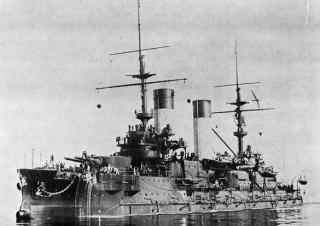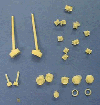

|
by Norm Koger |
||
|
Kniaz Suvorov was the Russian flagship at Tsushima
in 1905. I have wanted to build a model of this ship and the Japanese flagship
Mikasa for about 25 years. A couple of months ago I discovered that Combrig
of Russia makes a resin kit of the Suvorov, and Mikasa is now available
from Seals Models of Japan. Even though I hadn't built a model in almost
20 years, and have never built a resin kit, I couldn't resist. So I ordered
one of each: Mikasa from Hobby Link Japan
and Suvorov from Aviapress of Russia.
While I waited for the Russo-Japanese war ships, I picked up a 1/700
Classic Warships SMS Königsberg to brush up on modeling skills
and learn about resin kits.
While HobbyLink Japan was fairly fast, Aviapress took about six weeks to
deliver the Suvorov. Three weeks after ordering the Combrig Suvorov from
Aviapress I found out about the Modelkrak (Poland) Suvorov and ordered
it from Kitlink.com. The Seals Models
Mikasa is a gem, and I wanted to make sure I had the best possible Suvorov
model to display with it. Now all three models are here. It's building
time… |
to enlarge  |
|
MediumBoth Suvorov kits are entirely cast resin with quite
a few small parts. Neither kit includes photo etched or white metal parts.
For some reason the Combrig model is cast in three different colors – perhaps
different resin formulations.
|
||
|
|
Kit Parts |
Kit Parts |
| Both hulls are just under 17cm in length at the water line. The Modelkrak hull casting (upper right) is very clean, with good detail and very few bubbles or “voids”. There is a very thick (3mm +) casting plug. 3mm may not sound like much but it's actually thicker than the distance from the lowest external deck to the water line (about 2mm), so I suspect removing it without introducing an angle at the waterline may not be easy. Still, the Modelkrak hull looks nice. |
Click images
 |
to enlarge
 |
| The Combrig hull is another matter. There is no casting plug. Perhaps it might be better if there were, as the model appears to be a bit too low in the water. There are numerous bubbles and flash burrs which damage much of the small detail, and there are a number of shallow dents and cracks that will be difficult to fill. On my kit, there are sixteen locations on the hull that will require careful putty work to avoid gross finish flaws. All of the tie offs will have to be replaced with short lengths of 0.64mm plastic rod stock – something I don't look forward to, having just gone through it with another 1/700 resin kit. |  |
|
Small Parts |
 |
 |
| Both kits come with quite a few small cast resin parts, including superstructure levels, ship's boats, gun barrels, and mast details. Except for platform parts, you're better off building the masts from brass rod than using the included castings. Modelkrak’s tapered lower mast parts aren't bad if used as the foundation for brass assemblies, but they appear to be a bit short. |  |
 |
| The Modelkrak ship's boats are much better than those included with the Combrig kit, but all have small visible voids that will need to be filled. Superstructure parts are a mixed bag. Combrig’s superstructure parts are more delicately cast, with thinner decks and covered railings. Modelkrak’s superstructure parts are a bit heavy for the scale, but partly make up for it with wood plank texturing that the Combrig parts lack. Oddly, neither kit includes any pedestal mounted quick firing guns. |  |
 |
|
|
|
|
|
Both kits come with line drawings, although Modelkrak’s
is a bit murky. The Modelkrak line drawing is also inconsistent, with the
overhead view showing the amidships turrets along the same line as the
forward edge of the aft funnel while the side view shows more than 2 meters
of separation. This is troubling, as the discrepancy occurs exactly at
the spot where there is a major difference between the two models. Combrig’s
model is a very good match for the rather nice line drawing included with
the kit, and it is also a very good match for all of the photos and artwork
available on the web and in my personal reference books.
|
 |
 |
|
There is a particularly valuable set of photos
of the damaged Orel taken after Tsushima. One of these photos is absolutely
necessary in order to complete either of these models. Another clearly
shows that Orel, at least, had a prominent walkway that extended from one
side of the ship to another just forward of the aft funnel. The Combrig
kit includes this walkway while the Modelkrak does not. Generally Modelkrak’s
kit is at variance with all of the available photos and drawings. Indeed,
in some areas it is not a very good match for the line drawing included
on the kit's own instruction sheet. Most glaring, the forward turret spot
on the hull is so far forward that it will actually have to be cut back
by about 2mm – resulting in a rather unpleasant removal and rescribing
job to get the surface forward of the turret to match the rest of the deck.
The vertical distance between visible deck surfaces at the stern is clearly
out of scale, and the complex curves along the edges of the decks are not
nearly as good as Combrig’s. My first thought on looking closely at these
two kits: Are these really supposed to be the same ship? One or both of
the designers just about has to have used incomplete or incorrect references.
Combrig, for example, has a continuous structure near the base of the funnels
while Modelkrak shows two separated structures. I wish I knew which model
got it right. The variances aren't likely due to post commissioning changes.
Suvorov was completed less than one year before its loss at Tsushima. That's
not a lot of time for evolution. The best documented ships of this class
are Borodino and Orel. I wasn't able to find third party line drawings
of Suvorov. And that's a problem because Kniaz Suvorov, Imperator Alexander
III, and Slava were built at the Baltic Works, Orel at Galernii Island,
and Borodino at the St. Petersburg New Admiralty Yard. There could easily
be substantial differences between the ships of the same class produced
at different sites. The only certainty is that the Combrig kit seems to
be a very accurate model of Orel. But were Orel and Suvorov identical?
Which set of drawings and photos did Modelkrak and Combrig use?
|
||
BuildingNeither of these kits will build up to a really
presentable model right out of the box. The Combrig kit will require substantial
work to get a decent surface finish on the hull and restore details damaged
by poor casting. On the other hand, it is much more precisely and accurately
modeled than the Modelkrak. The Modelkrak will be easier to build into
a more presentable model due to its superior casting, but even it will
require some tricky work in front of the forward main gun turret. The assembly
instructions are limited to simple exploded view and line drawings, which
is just as well since the text is in Polish (Modelkrak) and Russian (Combrig).
So which kit do I plan to build? Looks like it will
be the Combrig, with assistance from some of the Modelkrak detail parts.
Combrig does so much better at capturing the complex shape of the hull
that the Modelkrak model isn't even in the same league. And the Combrig
can easily be modified away from its match to Orel to mimic the minor internal
superstructure differences shown on the Modelkrak kit if necessary. I just
wish the Combrig hull had been cast by the guys at Modelkrak.
I will be using a lot of brass stock Both kits really
require scratch built mast assemblies, many pedestal mounted quick firing
guns, supports
for ship's boats, and small sponson mounted guns just above the waterline.
The Modelkrak does make a half hearted attempt at modeling the lower hull
mounted guns, but it's best scraped off so you can start from scratch.
|
||
|
|
||
|
I had read a number newsgroup posts about ordering
from Aviapress and I was a bit concerned about them. But they were the
only outfit that had the Combrig Suvorov in stock I needn't have worried.
Aviapress wasn't particularly fast, but they did deliver the model in good
condition. I expect to order from them again. Contrary to some stories
I've read in newsgroups, the model was securely packaged in multiple layers
of heavy cardboard. On the other hand, tales of brown paper wrapping
and twine are true. I couldn't quite believe it when I finally saw the
parcel, and neither could my mail carrier. “Registered Russian Parcel sir.”
You should have seen the look on the mailman's face as he handed the package
over and watched me sign the Russian postal receipt document. That alone
was almost worth ordering from Aviapress. The most remarkable thing was
the seal on the back of the package. The brown paper / twine external wrapping
is apparently some kind of standard for Russian registered parcels, because
the ends of the twine are pulled back from the knot on the back of the
package and sealed (I kid you not) with a melted wax seal. I swear it looks
like it could have been mailed in the days of the Tsars. Below is a photo
of the package, with an inset of the postal seal at upper left.
|
 |
|
| Links: | ||